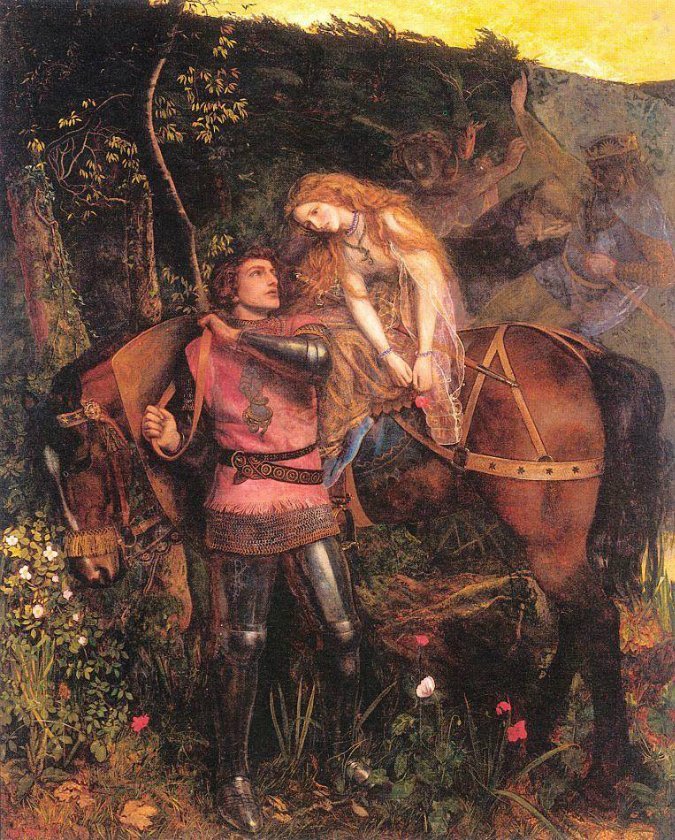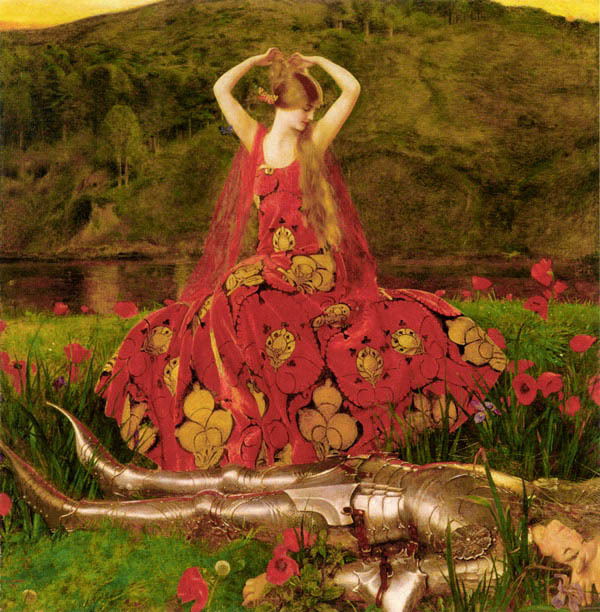In this post we’ll take a look at a very popular topic for the Pre-Raphaelite painters: the heroine of John Keats’s poem “La Belle Dame Sans Merci”. At once beautiful and cruel, this damsel enchants the poor naive knight and brings him to his doom.
 John William Waterhouse, La Belle Dame sans Merci, 1893
John William Waterhouse, La Belle Dame sans Merci, 1893
The most beautiful, the most captivating portrayal of the beautiful and cold-hearted lady from John Keats’s poem “La Belle Dame sans Merci” is, for me, the one painted by John William Waterhouse in 1893. The warm rich colours, her languid pose and the way she gazes at the poor knight linger in the memory. Winterhouse wasn’t particularly faithful to Keats’s vision of the setting; Keats described the scene of their doomed encounter as taking place in a desolate wintry landscape where no birds are singing. Waterhouse and other artists before and after him had envisaged the scene differently, which shows that sometimes motifs from poetry don’t translate well into visual arts. Still, the warm colours and details such as red leaves in the foreground suggesting that it’s late summer or early autumn, add to the sensuality of the theme. The autumn is not much different to the merciless lady; nature in autumn charms us with her richness, giving promises it won’t fulfill; the crimson leaves speak of luxury, yet they shall wither and fall in decay.
This is how the knight in the Keats’ poem describes the lady:
“I met a lady in the meads,
Full beautiful, a fairy’s child;
Her hair was long, her foot was light,
And her eyes were wild.”
Most unusually, but very fitting for the rest of the painting’s colour palette, Waterhouse painted the lady’s dress in a beautiful warm shade of purple, in a seductive and illusive colour of wine. And look at the heart on her sleeve. Her long auburn hair is falling down her back as she gazes transfixed at the knight, in the same way that the nymphs in Waterhouse’s other painting “Hylas and the nymhps” are gazing at the poor Hylas. Her ruby red lips, her long hair and sweet-scented air all lie; for it is not love that lies on her heart but deceit! And it is only the poor naive knight who is blind to it. And the nature is lying with her; white briar-roses bloom and the trees in the background, reminiscent of the early Renaissance painters, are silent and many dark things they wickedly withhold. The dense row of tall trees reminds me of the trees in Botticelli’s paintings from series “The Story of Nastagio Degli Onesti”, part one and two.
 Frank Dicksee, La Belle Dame sans Merci, 1902
Frank Dicksee, La Belle Dame sans Merci, 1902
Frank Dicksee was another painter who painted in the Pre-Raphaelite style, but just like Waterhouse he wasn’t the member of the original Pre-Raphaelite Brotherhood. There is something sentimental about his version which I don’t like, but I do love the lady’s long flowing red hair with a crown of white flowers on it. Here is John Keats’s poem, it is too beautiful not to be included:
O what can ail thee, knight-at-arms,
Alone and palely loitering?
The sedge has withered from the lake,
And no birds sing.
O what can ail thee, knight-at-arms,
So haggard and so woe-begone?
The squirrel’s granary is full,
And the harvest’s done.
I see a lily on thy brow,
With anguish moist and fever-dew,
And on thy cheeks a fading rose
Fast withereth too.
I met a lady in the meads,
Full beautiful, a fairy’s child;
Her hair was long, her foot was light,
And her eyes were wild.
I made a garland for her head,
And bracelets too, and fragrant zone;
She looked at me as she did love,
And made sweet moan
I set her on my pacing steed,
And nothing else saw all day long,
For sidelong would she bend, and sing
A faery’s song.

Arthur Hughes, La Belle Dame Sans Merci, 1863
She found me roots of relish sweet,
And honey wild, and manna-dew,
And sure in language strange she said—
‘I love thee true’.
She took me to her Elfin grot,
And there she wept and sighed full sore,
And there I shut her wild, wild eyes
With kisses four.
And there she lullèd me asleep,
And there I dreamed—Ah! woe betide!—
The latest dream I ever dreamt
On the cold hill side.
I saw pale kings and princes too,
Pale warriors, death-pale were they all;
They cried—‘La Belle Dame sans Merci
Hath thee in thrall!’
I saw their starved lips in the gloam,
With horrid warning gapèd wide,
And I awoke and found me here,
On the cold hill’s side.
And this is why I sojourn here,
Alone and palely loitering,
Though the sedge is withered from the lake,
And no birds sing.

Frank Cadogan Cowper, La Belle Dame Sans Merci, 1926
At last, the knight is defeated and the lady arises like a phoenix from the ashes with a victorious glow on her cheeks, hair even shinier and more beautiful – she is ready to strike again. Wild red poppies are swaying in the wind, dancing and whispering passionately of the poor knight’s death. Her dress is intricate and ornate, and, similar to Klimt’s designs, almost has a life of its own. Her hands are seductively placed above her head, while the knight is lying dead in the grass, poppies and a few dandelions around him make for a very striking and powerful scene. Whereas Waterhouse opted for a dreamy idyllic version of the theme, focusing on the lady’s intense seductive gaze, Cowper here isn’t shy at portraying her as a merciless vixen.




so lovely and really fascinating !
LikeLike
Thank you!
LikeLike